Do you ever think about the use of tinted lenses? Do you think that they are just for style purposes and do not have any use?
I hate to break it to you, you are very wrong! These are not for style or enhancing your aesthetics, but have an actual use.
Read till the end to know about its uses.
Tinted Nature Of Ski Goggles

You have seen and used different colored lenses while wearing sunglasses too. At that time, you might have noticed that some sunglasses work way better during the day than at night. And the same goes for some other sunglasses that work better at night. At that time you must have praised the brand of sunglasses for providing ultimate vision, but that was actually the lens tints at its prime work my friend!
How you did not even realize makes it more special! Because you are bound to not identify the work it does. And since you did not know, here is a list of the functions they perform for you;
Glare Reduction
You might face glare while on beaches and think that it is the worst. No honey, it is not! Glare is at its peak when you are at the top of the hill. Tinted lenses help reduce glare from bright sunlight reflecting off snow, ice, and other surfaces. This glare reduction enhances visibility and prevents discomfort.
UV Protection
UV protection is an essential feature needed in every type of eyewear. Tinted lenses offer UV protection by filtering out harmful ultraviolet (UV) rays from the sun. UV rays can be more intense at higher altitudes where you ski, and prolonged exposure can lead to eye damage. Tinted goggles provide an extra layer of defense against UV radiation.
Contrast Enhancement
You should know that various light conditions do not support the same tint of lenses. You are going to need lens tints of various colors to enhance contrast and depth perception in various light conditions. For example, orange or rose-colored tints can increase contrast in overcast or low-light conditions, while darker tints are better suited for bright, sunny days.
Reduced Eye Fatigue
If you purchase the right-colored tinted lenses, it is going to help reduce eye strain and fatigue largely! By maintaining optimal light levels and decreasing scrunching of eyes in bright conditions it leads to fewer headaches and stress in the eye. This is particularly important during long days of skiing.
Privacy
Have you ever felt like everyone has their eyes on you when you are skiing in a different terrain than your usual one? I know it feels gross! But this can be avoided just from a simple change of your lens. A tinted lens ensures your privacy whilst skiing in outdoor areas to which you are a stranger. They offer you a level of privacy by partially obscuring your eyes, making them invisible from public view.
But, for all this to work, you need the right tint lens attached to your goggles in the apt weather conditions. Don’t know what they are, right? Got you again!
What Colored Lens Tints Are Needed For The Particular Weather Conditions?

The first thing you should drill into your mind is the law of opposites. Always use color lenses, contrary to the weather. When in bright conditions, use dark-colored lenses, and when in dark conditions use light-colored lenses.
Dark lenses are used in bright light because, as there is already so much light, it filters the excess rays to prevent eye straining and glare reduction and provide you with a comfortable view with the right amount of light entering your eyes.
In low-light conditions, bright lenses are used because the light is already very low. Thus the bright lenses will use that low light to integrate within itself a light suitable enough for you to navigate through the fields seamlessly.
Do you now get why the rule of opposites is being applied here? Let me tell you some tint options to choose from in certain weather conditions.
Different colored lens tints are designed to enhance visibility and comfort in specific weather and light conditions. Here’s a general guide to help you choose the right colored lens tint for various weather conditions:
Dark Gray or Black
You see dark, you know it is for light conditions. These tints are ideal for bright and sunny days. They reduce overall light transmission and minimize glare. Dark gray or black tints are suitable for bluebird days with clear skies and intense sunlight.
Brown or Bronze
They are both light-colored and dark at the same time, serving two different weather conditions with the same tint. They enhance contrast and are well-suited for partly cloudy to moderately sunny conditions. They provide good glare reduction and depth perception, making them a versatile option.
Amber or Yellow
These tints are the best choices for overcast or low-light conditions. They enhance contrast and visibility in flat light, making contours and terrain features more sharp. Apart from flat light, they are also greatly effective on foggy or snowy days.
Rose or Pink
Similar to amber and yellow tints, pink-tinted lenses enhance contrast and visibility in low-light conditions. They are effective on overcast and foggy days.
Blue or Green
For the days when the sky cannot decide if it wants to rain or wants sunlight, these tints can be helpful. They are designed for partly cloudy to sunny conditions and offer good contrast enhancement. But they are often chosen as stylish wear and not for their use.
Clear or Light Yellow
When you see ‘light’, you know it is for the night. Clear or light yellow tints are ideal for night skiing and extremely low-light conditions. They provide maximum light transmission.
Conclusion
So, now you know about lens tints, their uses, and which one you should use for which weather conditions. I hope you are not going to mistake the tints for being a style statement again. Good luck!

